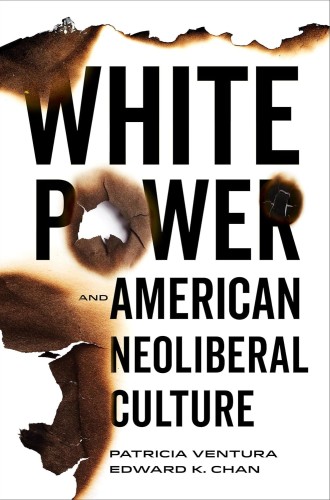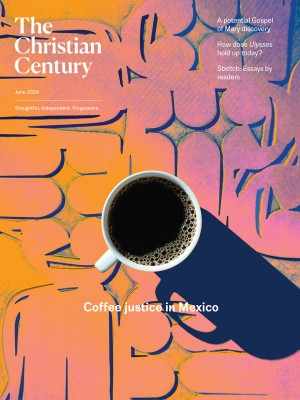Twin threats to democracy
Patricia Ventura and Edward Chan interrogate the ongoing enabling relationship between White supremacy and neoliberalism.

White Power and American Neoliberal Culture
It is rarely contested that a reciprocal relationship exists between White power and American neoliberal culture. As the public conversation around racial capitalism and the threat of White Christian nationalism to democracy increases, so does the awareness that neither neoliberalism nor White power could exist in its current form without the other.
Patricia Ventura and Edward Chan acknowledge that identifying the relationship between Whiteness and neoliberalism in a racialized free market system is not a novel observation. But they aim to interrogate further the sources of formation that have led to the ongoing enabling relationship between White power and American neoliberalism. These two traditions, Ventura and Chan argue, support one another “in ways that supercharge the power of both.”
Read our latest issue or browse back issues.
Neoliberalism, according to the authors, is “a sprawling term traditionally naming a set of capitalist economic approaches favoring financialization, business deregulation, minimal taxation, globalization, free trade, and market fundamentalism supported by states dedicated to corporate interests.” From this definition, the authors identify “neoliberal culture” as the “massive infrastructure shaping everyday life under neoliberal racial capitalism. It is like an ecosystem in which contemporary life is lived and emotions are felt.”
The goal of White Power and American Neoliberal Culture is to “analyze a deeply dangerous and growing threat to democracy and people’s lives that is installed at the fundamental level of capitalism.” The primary litmus test, write Ventura and Chan, is the investments made in the White, hetero-patriarchal family by proponents of both White power and neoliberalism. The shared threat that galvanizes the cooperation of these investments is not “big government in the form of the social welfare state” but instead a democratic republic “that would attend to the needs of nonwhite people and women who live outside the patriarchal family.” The central example of this convergence is Donald Trump, who embodies “the white power moment that reconnects us to American neoliberalism’s misty prehistory as a market-obsessed ‘theoretical utopianism’”—a term Ventura and Chan borrow from Mitchum Huehls and Rachel Greenwald Smith—“of economic freedom against centralized planning.”
The authors approach their task through several methods. First, they build on their previous scholarship—Chan’s on White power visions of dominance and Ventura’s on the culture of American neoliberalism—to examine their convergence in our nation today. Then they look back to the historic strategies that neoliberalism and White power have employed to maintain control, such as supporting the vision of the patriarchal family and reinforcing various versions of replacement theory mythology. Next they turn explicitly to the image of the ideal family at the heart of White power and neoliberal culture that is found in White power utopian fiction, including William Luther Pierce’s The Turner Diaries (1978), Kenneth Molyneaux’s White Empire (2000), David Lane’s KD Rebel (2001), and H. A. Covington’s The Hill of the Ravens (2003).
Chan and Venture identify a regime that flourishes within the supercharged co-enabling of White power and neoliberalism. This regime is fundamentally opposed to equality and democracy. It aims to dismantle notions of society, the commons, and social obligation in favor of radical individualism, maximized profit through racial capitalism, and the reestablishment of the White, hetero-patriarchal family.
One of the book’s important contributions is its rationale for why White middle-class people support the neoliberal system embodied by politicians like Trump. If these families and individuals are not financial benefactors of the no-holds-barred system of profit, why support it? The answer Chan and Ventura provide is that neoliberal culture at the site of Whiteness produces an idealized subject, Homo affectus, who becomes a central figure in the “emotional economy of the neoliberal workforce.” Citing sociologist Birgit Sauer, the authors note that much of the right-wing discourse creates a culture in which people “are given the right to be furious and passionate” and a set of lenses through which to perceive the world as if they were victims. As Chan and Ventura describe in their chapter on White power utopias, the goal of participating in this system is not necessarily the creation of an economic blueprint but “the idealization of whiteness as collectivity and consciousness.”
In other words, although the White middle class does not benefit financially from the neoliberal economy, it supports it nonetheless because neoliberal culture provides a sense of in-group identity through which its frustrations and sense of victimization are heard. When this shared racialized imagination is centered, the tensions between neoliberalism and White power are resolved.
According to the authors, the current movement toward social justice, racial equity, and inclusion has created a ripe opportunity for a neoliberal resurgence. Ventura and Chan tie this claim to the ongoing violence perpetrated by White supremacists today. They provide page after page of examples of people who commit violence in the name of White power—Dylann Roof, Wade Michael Page, Chris Harper-Mercer, Dionisio Garza, the Capitol insurrectionists. It is painful to read, but it emphasizes how crucial it is for us to reckon with the entanglement of White power and neoliberalism that magnifies and empowers both. In a constructive conclusion, the authors rightly acknowledge that any continued pursuit of justice in our world today must reckon with these realities of power, race, and capitalism.
Ventura and Chan broadly frame neoliberalism as pervasive among White conservatives. While we should have no tolerance for neoliberalism’s racist, fascist, and oppressive consequences, only a small faction of American conservatives are militant adherents of neoliberalism. More often, conservatives find solidarity in neoliberal culture but are unwilling to turn to neoliberalism’s utopian literature, extreme solutions, and material consequences—what Chan and Ventura present as a White “ethnonational” state—for answers to the issues of our nation. In short, while the authors are right to point out the threat to democracy found in the partnership of neoliberals and White supremacists, the power this group holds is minimal. I fear that by framing this group as being more pervasive than it actually is, readers will be tempted to frame all of their conservative peers in a neoliberal light.
Although pitched as short and accessible, White Power and American Neoliberal Culture is a thick read. Tremendous research has gone into creating this book, and the uninitiated must follow a rabbit trail of footnotes to make sense of key concepts in each chapter. For those invested in this conversation and knowledgeable about the history behind it, White Power and American Neoliberal Culture is certainly a valuable resource. For those seeking an introduction to this conversation and its place within the broader political discourse, I’d recommend starting elsewhere.





